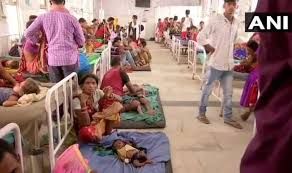Death Looms Over Muzaffarpur
Jun 22, 2019 • 23 views
Muzaffarpur, Bihar: this place has recently flared up in the news due to the reported deaths of more than a 100 children…100! Hundred families drowning in poverty, who trusted the state medical facilities to save the lives of their children; Hundred families who would not be mourning if proper education and action had been taken. The Acute Encephalitis Syndrome (AES), popularly known as brain fever has tormented the area for long, taking lives every year since 1995. But this year witnessed a record number of deaths, especially of children. So what was the reason for the spike in the number of cases?
Since the 1970s, almost 24 states have reported Brain Fever outbreak. In nearby Gorakhpur, it infected approximately 6000 people in 2005. Since then attempts have been made to raise awareness about the disease and its various aspects. AES is not a disease per se, it is “a group of clinically similar neurologic manifestations caused by several different viruses, bacteria, fungi, parasites, spirochetes, chemicals/ toxins, etc.” Its symptoms include mental confusion, dizziness, vomiting, seizures, fever, etc. various causes have been attributed to it. Earlier it was believed that humidity and heat wave are the culprits, but a 2017 study has confirmed that some toxins in the local litchis are the real cause. Doctors have also blamed hypoglycaemia, a condition where the blood sugar levels fall. Children from poor families who eat these native fruits, but go to bed on an empty stomach are critically vulnerable to this illness.
Doctors declared that this illness is preventable. After more than hundred children lost their lives and so many parents lost their only hope, the doctors declare that they could have been saved…what do you call this? Death by illness, or murder due to negligence and improper healthcare? Of the 250 plus children admitted in two state run hospitals of Muzaffarpur, many are expected to lose their battle to live and die due to AES. You ask for a reason, well there are many. But the most imperative of them are poor healthcare and medical awareness, which converges with poverty and illiteracy to lay down a dangerous nexus of sickness.

After the earlier outbreak of AES in the previous decade, government started awareness campaigns with vigor, but it all fizzled down. This year, it was reported that pamphlets were simply handed out to families without explaining anything about the illness. On top of that, the medical infrastructure is pathetic! State run Shri Krishna Hospital where majority of the deaths occurred, has 600 beds and 900 patients, along with a dearth in doctors and vaccines. One can see street animals and garbage lining the hospital premises. What makes it worse is the inescapable poverty which entails stunted growth, leading to malnutrition in over half of the local children. Illiteracy means that locals are unaware of the various health facilities and programmes they are entitled to. On top of that no efforts have been made to conduct research on the killer illness that took away so many lives!
In the wake of this health crisis, Bihar Health minister Mangal Pandey announced six ambulances for Shri Krishna hospital and increasing the ward capacity to 100. The Central Government has sent an enquiry team and recommended the setting up of research teams. These populist moves are too late for parents who will never be able to see their wards again. My question is, in this country, how much is too much? How many lives have to be lost till the government opens its eyes to mend its battered healthcare system? Do we always have to wait for tragedies to take measures? These questions remain unanswered as the government tries to do damage control. I guess wee will have to wait for the next election to get concrete answers!
